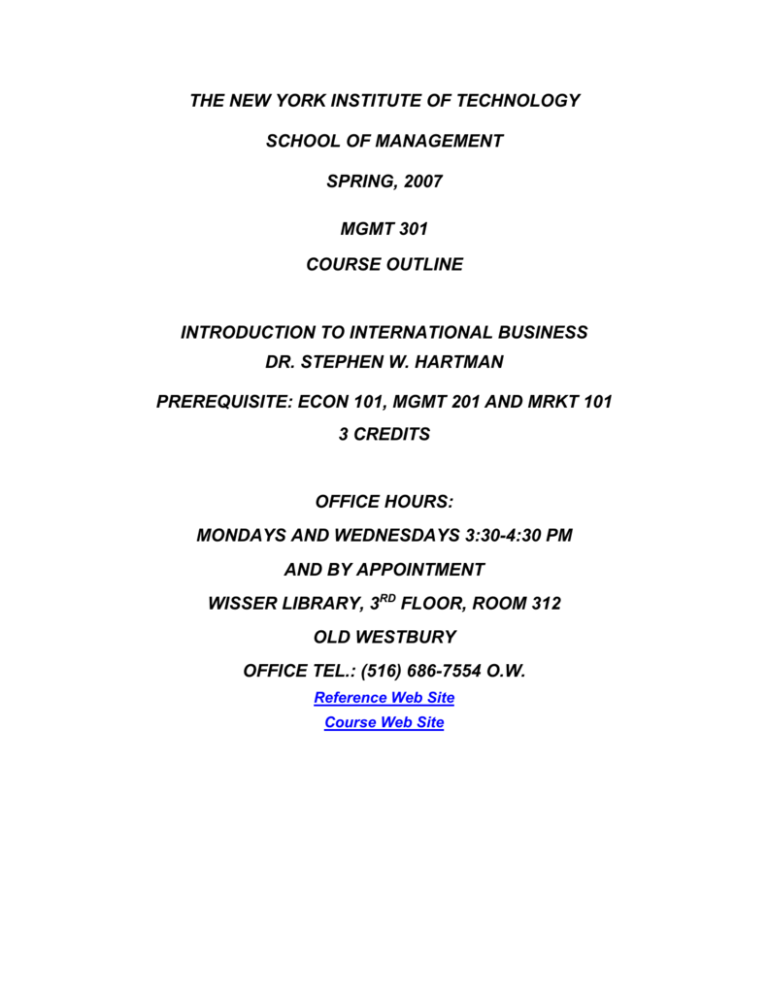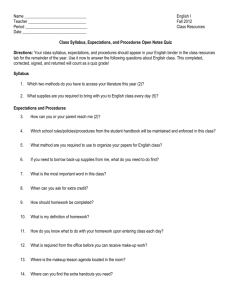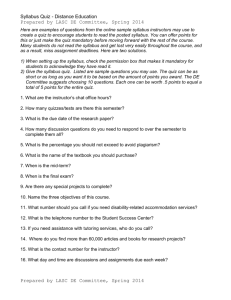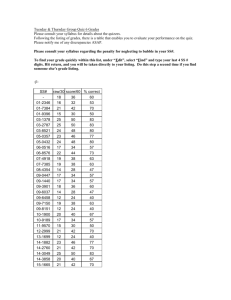MGMT 301 - New York Institute of Technology
advertisement

THE NEW YORK INSTITUTE OF TECHNOLOGY SCHOOL OF MANAGEMENT SPRING, 2007 MGMT 301 COURSE OUTLINE INTRODUCTION TO INTERNATIONAL BUSINESS DR. STEPHEN W. HARTMAN PREREQUISITE: ECON 101, MGMT 201 AND MRKT 101 3 CREDITS OFFICE HOURS: MONDAYS AND WEDNESDAYS 3:30-4:30 PM AND BY APPOINTMENT WISSER LIBRARY, 3RD FLOOR, ROOM 312 OLD WESTBURY OFFICE TEL.: (516) 686-7554 O.W. Reference Web Site Course Web Site 2 MGMT 301 INTRODUCTION TO INTERNATIONAL BUSINESS COURSE DESCRIPTION This course involves techniques for analyzing and understanding the world of international business. Students will examine the challenges posed by the multinational firm and the dynamic nature of international business. UPON SUCCESSFUL COMPLETION OF THIS COURSE, STUDENTS WILL BE ABLE TO: 1. Recognize the concept of the three environments and their forces. 2. Consider information presented to assist in comprehending the dynamic growth and the magnitude of both international trade and foreign investment. 3. Consider an overview of the theories of international trade and economic development for basic understanding and insight. 4. Discuss the reasons why international organizations are an extremely important subject with which business executives and students should be familiar. 5. Review the developing and constantly changing international monetary system. 6. Discuss the uncontrollable financial forces with which MNE's must contend. 7. See how the physical forces of location, topography, and climate influence both the controllable and uncontrollable forces. 8. See how the wide variety of attitudes and values among cultures affect managers of all business functions. 9. Investigate the political forces of nationalism, terrorism, unstable governments, international organizations, government owned businesses, various ideological forces, and how they affect the success or failure of a foreign venture. 10. Discuss laws concerning taxation, antitrust, imports, price and wage controls, labor, currency, and industrial property. 11. Discuss the composition, skills, attitudes, and union activities of an area's labor pool in terms of how they may affect productivity and profitability. 12. Understand how a firm's ability to compete frequently depends on its ability to obtain adequate channels of distribution. 13. Assess and analyze markets and market factors, indicators and screening. 14. Assess and analyze international marketing as it differs from domestic marketing. 15. Review export practices and procedure in international markets and marketing 3 GRADING PROCEDURES: MIDTERM AND FINAL EXAMINATINONS - 50% PROJECTS - 40% CLASS PARTICIPATION (ARTICLES) – 10% Complete On Time Project Assignments (within one Week of their due date) with correct grammar, spelling, footnotes and bibliography = Full Credit Complete Late Project Assignments (up to one Week after their due date) with correct grammar, spelling, footnotes and bibliography = One Letter Grade Penalty Complete Project Assignments more than 3 weeks late regardless of grammar, spelling, footnotes and bibliography = Two Letter Grade Penalty Missing or Incomplete Project (questions not completely answered and/or no footnotes or bibliography) Project Assignments = 0 Points Grades are assigned using the school's 13 point grading system for undergraduate course work. GRADES 95+ = A+ 92-94 = A 89-91 = A85-88 = B+ 82-84 = B 79-81 = B75-78 = C+ 72-74 = C 69-71 = C65-68 = D 0-64 = F REQUIRED TEXTBOOK Text: Ball, Donald A., and Wendell H. McCulloch, Jr. et. al. International Business, The Challenge of Global Competition, Irwin Publications, 10th Edition, 2005. ISBN 007-295802-2 Component of Pkg. ISBN 0-07-310576-7. Reference book: Dictionary of International Business Terms, York: Barrons Educational Series, Inc., 2004). 3rd 4 edition (New COURSE PROCEDURE This seminar will be an interactive process providing exposure to lectures, case studies, discussions, and research. The students are expected to have done all of the readings and course related work prior to the actual class session. Failure to do the readings and related work prevents the student from adequately participating in the classroom discussions and thus detracts from the overall quality of the seminar. Please do your part! STUDENT SUBSCRIPTIONS It is expected in this course that each student will at least read the Wall Street Journal. The instructor will make available a special student discount subscription form for those not having access to the paper. In recent years there has been a flood of business journalism as the environment of business assumes center stage importance in current day events. Students are therefore asked to consult other publications such as the New York Times Business Section, Forbes magazine, Money magazine, and the ETV program Wall Street Week, as well as TV business wrap-up programming. While it is impossible to keep up with everything, students should at least be aware of the major developments of the day. Consistent with this philosophy students are asked to cut out and bring to class one business article from the business press each class session. Additionally students should prepare at least a one half page summary of the article. It can be in handwriting. These articles will be collected at the BEGINNING OF THE CLASS. THEY ARE NOT ACCEPTED AT THE END OF THE CLASS! Prepare to be called on to discuss the contents of the article with the class. READ YOUR BUSINESS PUBLICATIONS! ASSIGNMENTS Please read the following chapters in your textbook follow the schedule for submission of all projects. Week 1: Chapter 1 The Rapid Change of Global Business. Read the chapter lecture, review the power point slides in the Course Documents area, and complete the chapter 5 quiz in the Syllabus area. Week 2: Chapter 2. International Trade and Foreign Direct Investment. Read the chapter lecture, review the power point slides in the Course Documents area, and complete the chapter quiz in the Syllabus area. Week 3: Chapter 3, Theories of International Trade and Investment, and Chapter 4, The Dynamics of International Organizations. Read the chapter lecture, review the power power point slides in the Course Documents area, and complete the chapter quizzes in the Syllabus area. Project 1 Review tables 2-2 and 2-3, World Trade in Merchandise Exports and Services in your textbook. Pay particular attention to the percentage share of worldwide exports in 1992 and 2002 for the following regions and selected countries: North America United States Latin America Africa Middle East Asia China India European Union France Italy Answer the following questions: 1. Are their any noticeable trends? 2. What are the implications of these trends? 3. In your opinion, why the growth in Asia as compared to the decrease for the European Union? 4. Africa and the Middle East’s percentage shares have decreased or remained stagnant, why do you believe this is the case? 5. Should you, as a future business leader, be concerned about these trends? Due February 12, 2007. Week 4: Chapter 5, Understanding the International Monetary System, and Chapter 6, sociocultural Forces: Influencing International Business. Read the chapter lecture, review the power point slides in the Course Documents area, and complete the chapter quizzes in the Syllabus area. 6 Week 5: Chapter 7. Natural Resources and Environmental Sustainability. Read the chapter lecture, review the power point slides in the Course Documents area, and complete the chapter quiz in the Syllabus area. Week 6: Chapter 8. Economic and Socioeconomic Forces. Read the chapter lecture, review the power point slides in the Course Documents area, and complete the chapter quiz in the Syllabus area. Week 7 Chapter 9, Political Forces. Read the chapter lecture, review the power point slides in the Course Documents area, and complete the chapter quiz in the Syllabus area. Week 8: Fifty question multiple choice questions covering chapters 1-9. Chapter 10, Legal Forces. Read the chapter lecture, review the power point slides in the Course Documents area, and complete the chapter quiz in the Syllabus area. Mid Term Examination. Fifty question multiple choice questions covering chapters 1-9. Week 9: Chapter 11, Financial Forces. Read the chapter lecture, review the power point slides in the Course Documents area, and complete the chapter quiz in the Syllabus area. Project 2: Use the globalEDGE site to complete the following exercises. Part One You are assigned the duty of ensuring the availability of 100,000 yen for a payment that is scheduled for next month. Considering that your company possesses only US dollars, identify the spot rate and forward exchange rates. What are the issues of utilizing spot versus forward exchange rates? Which one would you choose? How many dollars do you have to spend to acquire the amount of yen required? The currency exchange rates can be accessed via a variety of sources. A list of these sources is available http://globaledge.msu.edu/ibrd/ibrd.asp and can be accessed by searching the term “exchange rates.” The first resource listed under this search is the FX Street, located under the globalEDGE category “Money: Finance”. This site offers daily updated information about foreign exchange markets as forex news, market reports, forecasts, and real-time exchange rates and charts. A currency converter and historical tables are also available Search Phrase: “Exchange Rates” Resource Name: FX Street Website: http://www.fxstreet.com 7 globalEDGE™ Category: “Money: Finance” Part Two As an entrepreneur, you are interested in expanding your business to either Poland or Portugal. As part of your initial analysis, you would like to know how much investment is needed to go to these markets. In order to get a rough number, you hire a consulting firm to do initial investment analysis. The consulting firm provides you a short report about how much money is needed fro both countries. The numbers provided are: one million zloty (Poland’s currency) and 45 million escudo (Portugal’s currency). To make a clear comparison, you need to convert these currencies to US dollars. Do the conversion and suggest where to invest. The data source can be accessed by searching the term “Conversion” at http://globaledge.msu.edu/ibrd/ibrd.asp. The Conversion & Calculation Center is the first conversion resource in this search. This resource is found under the globalEDGE category “Reference: Standards and Conversions”. Search Phrase: “Conversion” Resource Name: Conversion & Calculation Center Website: Convert It globalEDGE ™ Category: “Reference: Standards and Conversions” Due March 12, 2007. Week 10: Chapter 12, Labor Forces, and Chapter 13, International Competitive Forces. Read the chapter lecture, review the power power point slides in the Course Documents area, and complete the chapter quiz in the Syllabus area. Week 11: Chapter 14 Assessing and Analyzing Markets. Read the chapter lecture, review the power point slides in the Course Documents area, and complete the chapter quiz in the Syllabus area. Week 12: Chapter 15, Entry Modes. Read the chapter lecture, review the power point slides in the Course Documents area, and complete the chapter quiz in the Syllabus area. Project 3: Interview an individual involved in exporting such as a member of a bank's international department or a local multinational's export department, a foreign freight forwarder, or a foreign trade specialist in the U.S. Department of Commerce or state government's department of commerce. Describe what they do and what their current experiences are. Due April 9, 2007. Week 13: Chapter 16, Export, and Import Practices. Read the chapter lecture, review 8 the power point slides in the Course Documents area, and complete the chapter quiz in the Syllabus area. Week 14: Chapter 17, Marketing Internationally. Read the chapter lecture, review the power point slides in the Course Documents area, and complete the chapter quiz in the Syllabus area. Week 15: Final Examination. The final exam is a 50 question multiple choice exam covering chapters 1-17. MGMT 301 PROJECT GUIDE 1. All Projects shall be typed double-spaced. The general length of the Project should be a maximum of five pages. 2. The questions being answered within each Project are to be clearly stated followed by the student's response. 3. Footnotes and bibliography: a) I strongly suggest using Kate L. Turabian, A Manual for Writers of Term Papers, Theses and Dissertations (Chicago: The University of Chicago Press, latest edition) as this still is the standard guide for writing term papers in the country. b) Footnotes may either be at the bottom of the page or on a separate piece of paper at the end of the text. However, footnotes inserted in the text are not acceptable simply because there is very little standard of agreement on their formatting and students invariably become confused with them. 4. Since so many of our students are using word processing to prepare their research papers, I strongly recommend students use the spelling checker option to reduce the number of spelling and typographical errors. In addition, I strongly recommend students use a grammar checker to check the grammar of all written work. 5. Acceptable research materials are authored articles in scholarly academic journals (see bibliography at end), government hearings, and other documents, internal research from an organization whether published or not, published books using original research rather than reviews of previously available research, and interviews. These are termed primary source materials. Newspaper and magazine articles are acceptable secondary source materials only if they are (1) authored and (2) used to supplement primary sources mentioned above. TEXTBOOKS ARE NOT ACCEPTABLE RESEARCH SOURCES OR DOCUMENTS. Go to the original sources. 8. All Projects are carefully read and criticized. The best way to get full credit for the Project is to do quality work and follow this guide. Plagiarism is a major No No! 9 Any student found to have plagiarized his or her research would fail the Project and the COURSE! GIGO! Bibliography International Strategic Management and Government Policy / edited by Peter Buckley. New York: St. Martin's Press, 1998. Meyer, William H. Human Rights, and International Political Economy in Third World Nations: Multinational Corporations, Foreign Aid, and Repression. Westport, CT: Praeger, 1998. International Business Strategies: Economic Development Issues / editors: Abbass F. Alkhafaji, Zakaria El Sadek. Slippery Rock, PA: International Academy of Business Disciplines, c1997. Phelps, N. A. (Nicholas A.) Multinationals and European Integration: Trade, Investment, and Regional Development. London; Bristol, Pa.: J. Kingsley Publishers; London: Regional Studies Association, c1997. James W. McKee Forum on International Management (1st: 1994: New York, N.Y.) Making International Strategic Alliances Work / edited by Margaret Hart and Stephen J. Garone. New York, NY: Conference Board, c1994.







